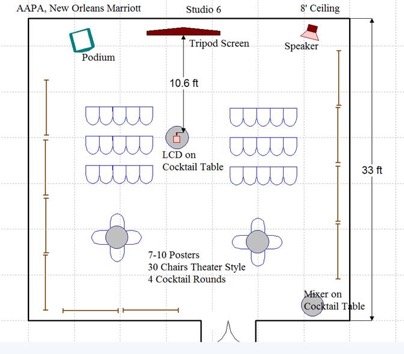
Poster Symposia offer the opportunity to present research in an intimate and less rushed environment than is normally the case for regular podium or poster sessions. Poster symposia are accommodated in private rooms, AV equipment can be supplied, and there is the opportunity for catering (at the organizers own expense).
Many poster symposia begin with a formal introduction by the organizers, followed by time to view the posters, comments by discussants, and a question and answer period. Some also include specific time for presentation of, for example, new software or fossil material.
The following is an example of the layout of a poster symposium room for a tribute symposium held at NOLA in 2017. This is followed by another example of a poster symposium also held at NOLA.
Example 1: Anthropological Stories of Bone Histology and Remodeling: An Invited Session in Honor of Samuel D. Stout, Chair: Sabrina C. Agarwal, held in the New Orleans Marriott, Studio 6, 8:00am – 12:pm.
 Sam
Stout pioneered the early work on bone histomorphometry in ancient bone, and
over the past decades his work has established the significant methodological
and scientific contribution of histological studies to biological anthropology.
He has examined some of the most fundamental aspects of skeletal variation
including patterns in bone remodeling with disuse, taphonomy, population
variation, biomechanical loading, bone remodeling in early hominids, and
changes with disease and aging. He has continued to develop new microscopic age
estimation methods and push our understanding of intra-skeletal variation in
bone mass and microstructure. This session brings together the research of his
colleagues and the students he has mentored to celebrate the stories and new
trajectories from this work that have served to clarify the fundamentals of
bone biology for generations of scholars in skeletal biology, forensic
anthropology, paleoanthropology & bioarchaeology.
Sam
Stout pioneered the early work on bone histomorphometry in ancient bone, and
over the past decades his work has established the significant methodological
and scientific contribution of histological studies to biological anthropology.
He has examined some of the most fundamental aspects of skeletal variation
including patterns in bone remodeling with disuse, taphonomy, population
variation, biomechanical loading, bone remodeling in early hominids, and
changes with disease and aging. He has continued to develop new microscopic age
estimation methods and push our understanding of intra-skeletal variation in
bone mass and microstructure. This session brings together the research of his
colleagues and the students he has mentored to celebrate the stories and new
trajectories from this work that have served to clarify the fundamentals of
bone biology for generations of scholars in skeletal biology, forensic
anthropology, paleoanthropology & bioarchaeology.
8:00am: Introduction: Sabrina C. Agarwal.
10:30am: Participant Discussion.
Example 2:
Diversity, Variation, and Paleoecology: A View of Hominin Complexity
from the Middle Pliocene of Eastern Africa Organizers/Chairs:
Amy L. Rector, Denise F. Su, Kaye E. Reed, 2:30pm – 6:30pm.
Hominin fossil discoveries in the last two decades have dramatically increased the taxonomic diversity of hominin species from the middle Pliocene (~4-3 Ma) of eastern Africa. Detailed morphological, geological, and paleoecological studies show that this increase in diversity is not limited to taxonomic representation, but also to habitat, diet, and locomotion. This symposium brings together experts in hominins, paleoecology, and geology to synthesize the data from the last twenty years and examine the implications for our understanding of early hominin evolution.
2:30pm: Individual poster presentations (Odd posters).
3:30pm: Individual poster presentations (Even posters).
6:00pm: Discussants: William Kimbel and Carol Ward.
Copyright © 2025 American Association of Biological Anthropologists.
Site programming and administration: Ed Hagen, Department of Anthropology, Washington State University